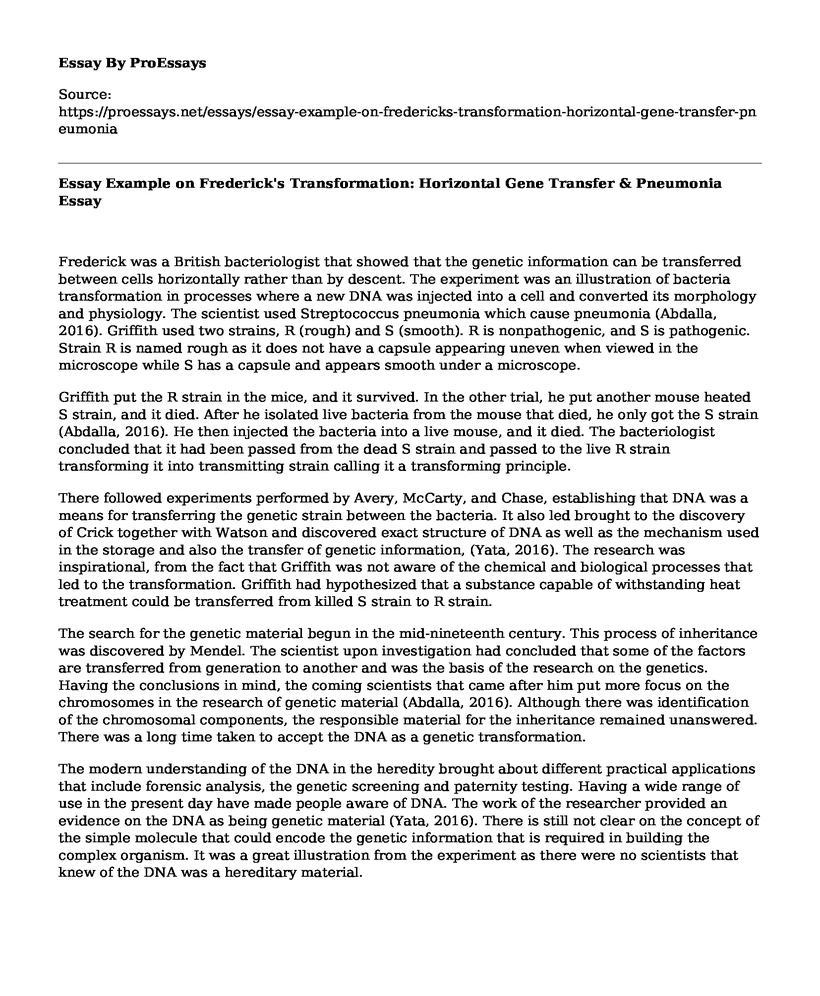Frederick was a British bacteriologist that showed that the genetic information can be transferred between cells horizontally rather than by descent. The experiment was an illustration of bacteria transformation in processes where a new DNA was injected into a cell and converted its morphology and physiology. The scientist used Streptococcus pneumonia which cause pneumonia (Abdalla, 2016). Griffith used two strains, R (rough) and S (smooth). R is nonpathogenic, and S is pathogenic. Strain R is named rough as it does not have a capsule appearing uneven when viewed in the microscope while S has a capsule and appears smooth under a microscope.
Griffith put the R strain in the mice, and it survived. In the other trial, he put another mouse heated S strain, and it died. After he isolated live bacteria from the mouse that died, he only got the S strain (Abdalla, 2016). He then injected the bacteria into a live mouse, and it died. The bacteriologist concluded that it had been passed from the dead S strain and passed to the live R strain transforming it into transmitting strain calling it a transforming principle.
There followed experiments performed by Avery, McCarty, and Chase, establishing that DNA was a means for transferring the genetic strain between the bacteria. It also led brought to the discovery of Crick together with Watson and discovered exact structure of DNA as well as the mechanism used in the storage and also the transfer of genetic information, (Yata, 2016). The research was inspirational, from the fact that Griffith was not aware of the chemical and biological processes that led to the transformation. Griffith had hypothesized that a substance capable of withstanding heat treatment could be transferred from killed S strain to R strain.
The search for the genetic material begun in the mid-nineteenth century. This process of inheritance was discovered by Mendel. The scientist upon investigation had concluded that some of the factors are transferred from generation to another and was the basis of the research on the genetics. Having the conclusions in mind, the coming scientists that came after him put more focus on the chromosomes in the research of genetic material (Abdalla, 2016). Although there was identification of the chromosomal components, the responsible material for the inheritance remained unanswered. There was a long time taken to accept the DNA as a genetic transformation.
The modern understanding of the DNA in the heredity brought about different practical applications that include forensic analysis, the genetic screening and paternity testing. Having a wide range of use in the present day have made people aware of DNA. The work of the researcher provided an evidence on the DNA as being genetic material (Yata, 2016). There is still not clear on the concept of the simple molecule that could encode the genetic information that is required in building the complex organism. It was a great illustration from the experiment as there were no scientists that knew of the DNA was a hereditary material.
Conclusion
The earlier scientists thought that the proteins that were in the DNA was a sought after material in genetics. The proteins have diverse amino acid sequences. While Avery showed that DNA is a transformational factor, it led to other scientists looking for that transformational factor (Yata, 2016). They paid more attention on proteins and DNA and the chemicals on focus were those that they were aware of chromosomes. There is a package of the nucleic acid that is wrapped in the coat of protein.
References
Abdalla, K. O. (2016). The Structure and Function of DNA-Part I. http://repository.gaduniv.edu.sd:8080/xmlui/bitstream/handle/123456789/274/L8%20DNA%20structure%20%26%20function.pdf?sequence=1&isAllowed=y
Yata, T. (2016). Development of efficient amplification method of DNA hydrogel and composite-type DNA hydrogel for photothermal immunotherapy. https://repository.kulib.kyoto-u.ac.jp/dspace/bitstream/2433/215494/3/dykkk00056.pdf
Cite this page
Essay Example on Frederick's Transformation: Horizontal Gene Transfer & Pneumonia. (2023, Aug 29). Retrieved from https://proessays.net/essays/essay-example-on-fredericks-transformation-horizontal-gene-transfer-pneumonia
If you are the original author of this essay and no longer wish to have it published on the ProEssays website, please click below to request its removal:
- The Controversy of Wild Animals in Captivity Essay
- Essay Sample on Endangered Species: Gray Wolf
- Plant Gene Breading and Human Gene Editing Paper Example
- Exploring North Carolina's 'Outer Banks': From Beachfront to Atlantic Graveyard - Essay Sample
- Essay Example on Auditory System: Sensory Organs, Motion Tasks, and Cortex
- Genetically Modified Organisms: Ethical, Safety, and Production Concerns - Essay Sample
- The Unconditional Love of My Pet Dog: A Bond That Lasts Forever - Essay Sample







